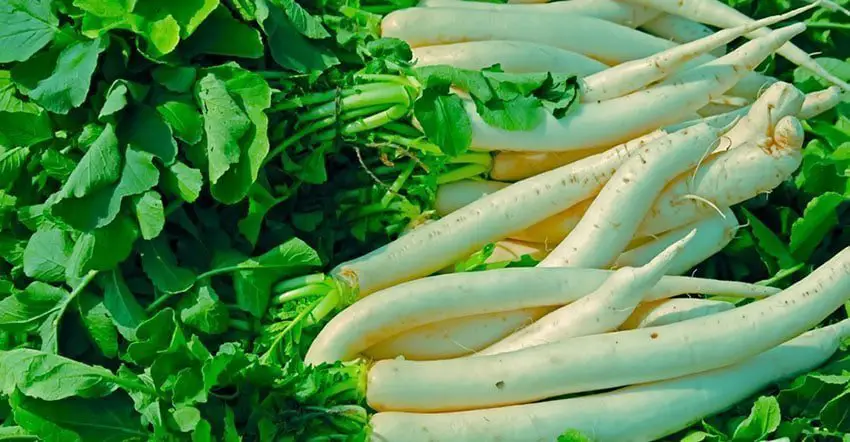How to Store Radishes – The Perfect Orbs of Goodness

Radishes, those perfect orbs of goodness, can be grown at various times of the year and are the perfect addition of crunch and often the right touch of flavor variance to your meal. They grow round, or long (similar in shape to a large carrot), or in a cylinder shape. Depending on the variety you choose to plant, they come in a variant of color from purple, red, white, and even black.

They are excellent eaten raw or cooked in dishes. In their prime they are firm and crisp, but if not stored properly, they can become rubbery in texture, limp and the least desirable root veggie to add to your meal. Today, let’s take a look at how to preserve the crispy perfection of these wonder roots.
Radishes to the Rescue
Radishes aren’t just satisfying to crunch, they are tasty and packed full of powerful goodness that fights off many ailments in our bodies.
Nutrients, Vitamins, Minerals
First, alone one radish contains approximately 6% of the daily dietary fiber recommended by the USDA. They are low in carbohydrate count, low in calories, and contain zero fat. One radish contains 25% of the daily recommended amount of Vitamin C. They also contain folate, Vitamin B6, Vitamin K, Riboflavin, Potassium, Copper, Manganese, Calcium, and Iron.
Health Benefits
The topic that seems to be in most readers minds is weight loss, so yes, radishes, because of their fiber content, are a low calorie filler that helps eaters lose weight. Their low glycemic index makes them a healthy way to eat your fill but lose pounds as well.
Radishes are also a great source for a type of flavonoid called anthocyanins, which have been linked to reducing cardiovascular disease, and exhibiting anti-cancer and anti-inflammatory properties.
The whole GI tract is benefited by the nutrients in radishes. They are diuretic by nature, they reduce inflammation, cleanse kidneys, and help create a resistance to urinary system infections. They also help with the development of bilirubin which reduces jaundice in the human body.
They help blood pressure due to their potassium content and these little veggies are great for skin disorders too, since they are high in vitamin C and contain some zinc, some vitamin B components, and phosphorus. These roots are full of natural water content and can make a great disinfecting face cleanser when smashed or pureed.
Ravishing Radish Uses
You’ve probably seen a salad with slices of red rimmed white discs, but that is only the beginning. Cooks can add julienne slices to Mexican dishes for a tangy zing. They can be substituted for turnips, carrots, or other root variety veggies. Larger radishes can be quartered and added to stews and soups. They can be a side of their own when you braise them in butter and red wine vinegar, and serve them alongside a strong meat, like lamb. Certainly not last, as the uses are plentiful, consider stir-frying thin slices with a flavorful oil and scallions, until browned. Then serve the stir-fry atop pan-seared fish or chicken. You can eat the tops too, they are great in salads.
Growing, Harvesting, and Storing
For such a hearty little veggie, it only makes sense to plant your own garden with these amazing roots. They mature quickly, are simple to grow and can be sown in the spring and in the fall.
Growing
Radishes can grow in nearly any zone and nearly any soil type, but they require full sun. However, they don’t thrive in the warmer summer months so a spring and fall crop is your best chance for a bounty of bulbs to harvest. Plant them 4-6 weeks the estimated date of the last frost. Since the purpose of this article is not to focus on the growth, but rather storing of radishes, we recommend following the instructions on the seed packets.
Harvesting
As we have already mentioned, radishes mature rather quickly, sometimes within the first month of planting. Look for large size bulbs for the variety you have sown, and be careful not to harvest too soon, but don’t leave them in the ground too long either. Roots left in the ground too long become woody in texture and lose their edible appeal.
When harvesting, grab the entire greens top with your hand (like holding a ponytail) and give a steady pull, releasing the bulb from the soil.
Storing
Not all readers will be growing and harvesting their own crop of radishes, but everyone who intends to eat radishes should make a habit of washing them thoroughly.
If you intend to eat the roots within a week, storing them at room temperature, in a water filled bowl, with the tops remaining (they might appear to be growing out of the bowl and that’s exactly what they should look like). You can stretch this time to as many as eight days if you place the bowl in the refrigerator.
For extended storage times, cut off the greens, do NOT wash them, and place them in a plastic zip up baggies with a moist paper towel. Place the bag in the crisper drawer of the refrigerator, which is cool, and dark most of the time, with the moisture sealed in the bag.
Another alternative exists for those in areas where cellars and basements are common. You will want to find a box or crate, fill it with damp play sand. Remove the tops, but leave the tap roots on the bottom. Layer the radishes in the sand but be careful to not to allow any of the roots to touch. Touch can spread rot if it does happen. Check few weeks for rot amount the radishes and remove any that have turned. Done properly, this storage technique will extend the life of the radishes to approximately three months. This is the best application for fall and winter radishes.
Some gardeners can actually keep the radishes in the ground. If you live in an area with a mild, but cold winter, the radishes can be planted 30 days prior to the first frost expectation. The cold temperatures will cause the root growth to go dormant, at that point you simply need to insulate them with a heavy layer of straw or hay (approximately 4-5 inches of insulation is preferred). The radishes can be removed in small groups as long as the ground doesn’t freeze.
Wrapping up with Radish Storage
Radishes shouldn’t be overlooked when plotting your garden, or even your next grocery shopping trip. They are a power packed veggie that is worth the effort. Have confidence loading up with these radiant roots and enjoy the harvest for days to come.

